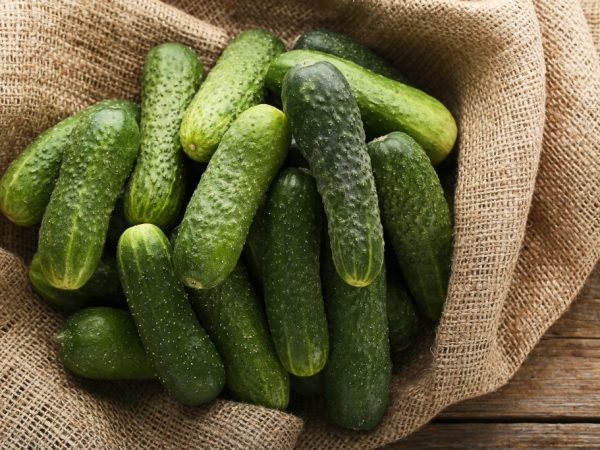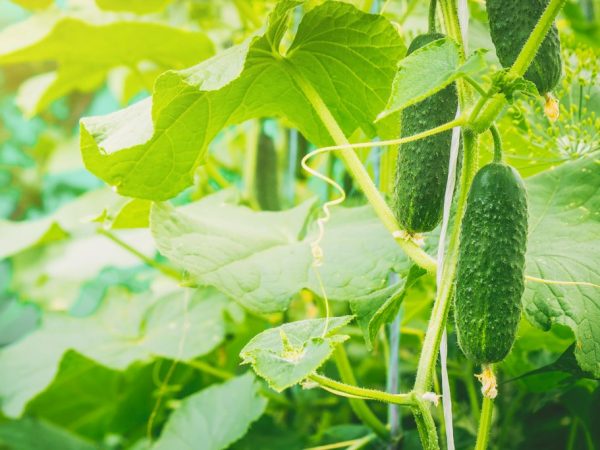Characteristics of cucumbers varieties Hummingbird F1
Cucumber variety Hummingbird F1 stands out due to its hybrid origin. This variety is grown for the purpose of obtaining pickles and gherkins. Cucumbers have good immunity and do not need any special care.

Characteristics of cucumbers varieties Hummingbird F1
Characteristics of the variety
According to the description, F1 Hummingbird cucumbers have a number of distinctive characteristics:
- fruitfulness - 9 kg per 1 sq. m;
- ripening time - 38-40 days, due to which the variety is considered early ripening;
- versatility of use.
Hummingbird cucumbers grow in temperate climates. The culture tolerates adverse weather conditions well. This variety is also suitable for balcony cultivation.
Description of the bush
The bushes are parthenocarpic. The weave is bunchy, shoots grow quickly. Lateral shoots are small. The plant has female-type flowers. Each knot in the leaf sinus forms 2 to 8 ovaries. With an uneven collection of fruits, the greens do not outgrow.
Small, dark green foliage is parallel to the soil. The bush is indeterminate, the internodes of the main stem are short.
Description of fruits
Zelentsy for sale must have certain commercial qualities.
Characteristics of cucumber fruits:
- length - 5-8 cm;
- diameter - 2.5-3.5 cm;
- weight - 60-80 g.
The pulp of the fruit is crispy, without cavities and bitterness. Seeds are small or completely absent. The shape is cylindrical, narrowed towards the peduncle. The surface of the fruit is covered with small bumps and white thorns. There are also longitudinal light stripes on the skin.
To grow pickles, cucumbers are harvested daily after the start of fruiting. Gherkins are harvested every 2 days.
Care
The seeds can be planted both outdoors and indoors. Lashes in an open area are buried with a film, for convenience they use trellises: this accelerates development. Before planting on the site, the seeds are germinated. By planting seeds using the seedling method, you can get fruits earlier than the indicated dates.

Yield depends on care
Cucumbers Hummingbird F1 do not require special care, but compliance with the rules contributes to the development of a high-quality harvest. To grow strong cucumber fruits, you need to pay attention to:
- watering mode;
- fertilizer;
- loosening and shaping bushes.
Watering
Cucumbers need a lot of moisture. Before the start of active flowering, it is necessary to apply 5 liters in dry weather and 2 liters after precipitation. During fruiting, cucumbers require up to 8 liters of water during drought and 5 liters after rain.
It is necessary to water the bushes in the morning with warm water. Watering in the evening when planting in spring can cause cooling of the root system due to unstable temperatures.
Loosening
Precipitation and irrigation lead to the formation of a hard crust on the soil surface. Its appearance can slow down the development of the lashes. After watering, the soil is loosened.
The root system of cucumbers is close to the surface of the ground, so hilling and weeding should be done carefully.
Fertilizers
Top dressing is applied at least once during the period of active growth.Mixtures containing nitrogen, potassium and magnesium are used as fertilizers. Some additionally fertilize the bushes during irrigation.
Organics are popular for feeding bushes:
- infusion on onion peel;
- dairy products;
- diluted chicken manure or animal manure.
Organic animal feed attracts harmful insects. You cannot use chicken droppings or manure as top dressing if neighboring gardens are infected with a bear or whitefly.
Pruning

Fruits need sunlight
The formation of the bush allows the lashes to receive the maximum amount of sunlight. This improves the quality of the fruit. Only the lateral lower shoots should be cut off, while keeping the central stem and other lashes intact: they form ovaries that participate in the formation of cucumbers.
Diseases
F1 hybrids are inherently immune to many common diseases such as olive spot and cucumber mosaic. However, in unfavorable growing conditions, cucumbers can become infected with a fungus.
Treatment of bushes for prevention purposes is carried out once a season. Solutions of mineral origin are applied before the formation of ovaries. Organics can be used until the end of fruiting.
The early maturity of the culture does not allow the use of heavy agrochemicals: such mixtures make the greens toxic.
Treatment
Most solutions are prepared at home from available components:
- Powdery mildew is considered the most common disease in cucumbers. A similar disease occurs due to hypothermia of the roots. Also, the reason may be an excess of nitrogen elements in the soil. Preventive measures include treating the root systems with a solution of milk, iodine and laundry soap.
- Peronosporosis appears in places with high humidity. The disease affects the foliage with a brown bloom and leads the plant to death. Fermented milk products help prevent the onset of the disease.
- Gray and white rot damages the stem and roots of the bushes. Excess moisture is also the reason. Urea solution helps fight infection. Dilute 10 g of the drug into 10 liters of water.
Pests
For species of hybrid origin, pests pose a greater threat than diseases. Some of the insects destroy the stems and roots of plants during the growing season, some attack the fruits. The most common pests are spider mites and slugs. These insects cause significant damage to the crop, destroying both the fruits and the bushes themselves.
Do not give up on prevention, as this will help protect crops from pests.
Prophylaxis
Pest prevention is carried out during the autumn soil preparation. Before the onset of cold weather, the earth is dug up without breaking large clods of earth. During frosts, weed seeds and larvae of harmful insects die.
You can also plant onions, garlic and dill between the rows: the smell of these plants repels pests. Before growing seedlings or sowing in open ground, the seeds are calcined to strengthen the immunity of future plants.
Conclusion
Cucumbers of the Hummingbird F1 are distinguished by their competitiveness: high taste and disease resistance attract many gardeners. Also, zelents have good keeping quality, which allows them to be transported over long distances.


